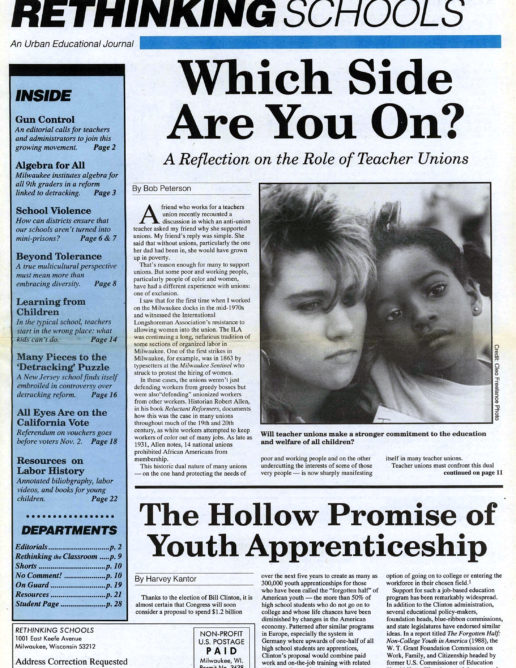Teachers Must Join Call for Gun Control
A Milwaukee high school teacher asked one of his classes the other day how many kids had access to a gun. They all raised their hands.
Another teacher, in another city and state, had three separate gun battles outside her school in the opening weeks of classes.
In Wyoming, meanwhile, a man fired 29 rounds into a school football field in September, injuring four of the 31 students on the field before killing himself.
Ask any teacher and they are sure to have similar horror stories. Violence has become topic number one in many schools.
The issue of violence and schools is a complex phenomenon. Two articles in this issue touch on some of the complexities (see pages 6 and 7). They offer perspectives about how to ensure that, in the rush toward metal detectors and ID badges, school officials remember that violence is essentially a social problem and requires social solutions.
We would like to raise another issue. While not within the power of school officials to control, it is an essential ingredient in any anti-violence agenda. And that issue is gun control.
We believe that anyone who is serious about resolving the problem of violence in our schools must deal with the unavoidable reality that there are too many firearms in the streets and homes of America. We’re not just talking BB guns used to take potshots at mailboxes and tin cans. We’re talking semi-automatic weapons that can wipe out a classroom in seconds.
Gun control will not magically resolve the problem of violence in our schools. But it potentially could ease the ultimate parental fear: that one’s child may leave for school in the morning only to be dead or seriously injured by nightfall.
Consider the Following
Anyone who does not believe in the necessity of gun control should consider the following:
- Nearly 10% of youths aged 10 to 19 have shot at someone or someone has shot at them, according to a recent Louis Harris survey. Some 59% of those polled said they have access to a handgun.
- Firearms kill more people between the ages of 15 and 24 than all natural causes combined.
- There were 22 handgun murders in 1990 in Britain, 68 in Canada, and 10 in Australia — all countries with strict gun control. By comparison, the number of homicides in the United States committed by a handgun is currently about 13,000 a year.
- Gun deaths, including suicides, now total more than 37,000 a year in the United States.
Across the country, there is a growing movement in support of gun control.
Teachers and school officials, who have chosen a career whose purpose is to nurture youth and help prepare them for the future, should be in the forefront of this movement.
Doctors and Gun Control
In taking up this issue, teachers and school officials could follow the example of those public health doctors who are raising gun control as a public health concern.
As the new head of the Centers for Disease Control (CDC), Dr. David Satcher, recently told TheNewYorkTimes: “I don’t think you have to take anything away from the CDC’s historic role in order to say that if you look at the major cause of death today it’s not smallpox or polio or even infectious diseases. Violence is the leading cause of lost life in this country today. If it’s not a public health problem, why are all those people dying from it?”
Just as gun control is an essential public health issue, it is an essential educational issue. If our students do not feel safe in the schools, how can they be expected to learn? If our students get an A in math only to be shot down on the streets, what is gained?
While many teachers and school officials actively support gun control as individuals, it is time to press this issue collectively.
Teacher unions, school boards, professional associations, and PTAs alike should go on record supporting gun control.
No, gun control won’t solve the problem of violence in our schools. But any solution that doesn’t address gun control will be a phantom panacea.

